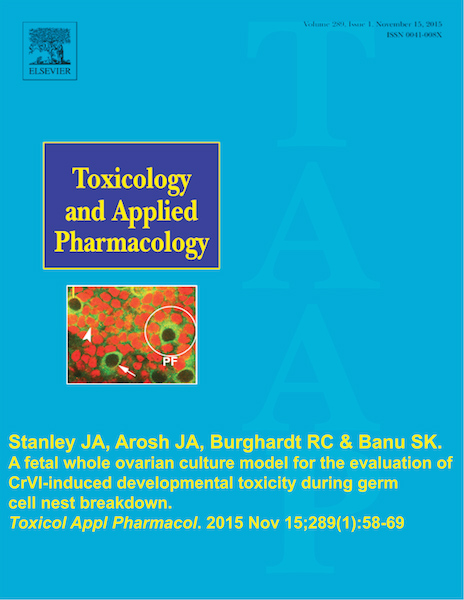Texas A&M Researchers Discover How Hexavalent Chromium Impacts Early Ovarian Development
Hexavalent chromium (CrVI), a toxic form of the heavy metal chromium, is widely used in more than 50 industries such as welding and painting. Due to increased usage and improper disposal, CrVI contaminates the environment, including drinking water. New research from the Texas A&M College of Veterinary Medicine & Biomedical Sciences (CVM) indicates that, despite its widespread use, CrVI can cause detrimental health effects, particularly when it comes to fetal ovarian development.

The study, which appears on the cover of Toxicology and Applied Pharmacology, examined developing rat whole fetal ovaries in cell cultures to explain how early exposure to CrVI causes cell death, known as apoptosis, in the female offspring’s developing ovaries. Ultimately, increased apoptosis during ovarian development can lead to premature ovarian failure and early menopause in the adult life.
“My main goal is to see what happens to the children if pregnant women are exposed to hexavalent chromium, since it readily crosses the placenta and directly targets the fetal organs, mainly the ovary,” said Dr. Sakhila Banu, assistant professor in the Department of Veterinary Integrative Biosciences and the lead author of the study.
Banu and other Texas A&M researchers studied the effect of CrVI on rat ovaries grown in a cell culture in the earliest stages of development-as soon as cells began to develop into ovaries. They looked at several genes and proteins that regulate the ovary’s development and the onset of apoptosis in ovarian cells.
Although it is normal for cell death to occur in some cells during the development of the ovary, accelerating apoptosis during early ovarian development can have consequences later in a woman’s life.
“Many chemicals can cause cell death,” Banu said. “If liver cells or intestinal cells are targeted they rejuvenate to a certain extent. But, every woman is born with a specific number of immature eggs, called oocytes, in the ovary. If during early development the oocytes are exposed to chromium, which particularly targets those cells, and if chromium accelerates those molecular pathways that program cell death, then you could end up with premature ovarian failure.”
Additionally, the researchers noted that this study creates a model in which the whole fetal ovaries can be grown in a organ culture for direct examination to determine harmful effects of chemicals on ovarian development. Thus, future research can be done to better understand the effects of other chemicals, such as drugs or environmental contaminants, on ovarian development.
Currently, the U.S. Environmental Protection Agency recommends 0.1 parts per million (ppm) as the safe limit for chromium in drinking water. However, Banu and her team determined that this level was still high enough to cause ovarian damage, suggesting that the regulatory limit of chromium be revisited.
“Dr. Banu is a highly productive young scientist and a leader in the area of chromium toxicity mechanisms and remediation strategies through funding support from the National Institute of Environmental Health Sciences,” said Dr. Robert Burghardt, associate dean for research and graduate studies at the CVM. “This is another outstanding example of One Health research being conducted at the College of Veterinary Medicine & Biomedical Sciences that benefits animals, humans, and the environment.”


